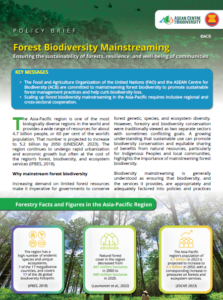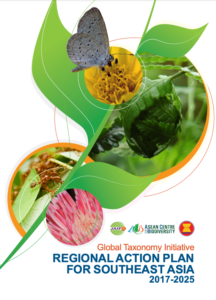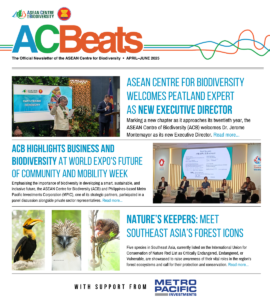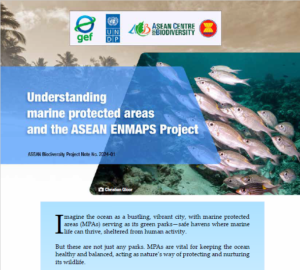New ASEAN Heritage Parks. 1) Tengku Hassanal Wildlife Reserve, 2) Bako National Park, 3) Lambir Hills National Park in Malaysia, 4) Pu Mat National Park, 5) Dong Nai Culture and Nature Reserve, and 6) Xuan Thuy National Park in Viet Nam.
Reinforcing its commitment to boost protected area conservation in the region, ASEAN has officially declared six sites from Malaysia and Viet Nam as the newest additions to the growing network of ASEAN Heritage Parks (AHPs) during the recently concluded 18th ASEAN Ministerial Meeting on the Environment (AMME-18) held in Langkawi, Malaysia.
Malaysia’s Tengku Hassanal Wildlife Reserve, Bako National Park, and Lambir Hills National Park were named as the 64th, 65th, and 66th AHPs, while Viet Nam’s Pu Mat National Park, Dong Nai Culture and Nature Reserve, and Xuan Thuy National Park were designated as the 67th, 68th, and 69th AHPs, respectively.
The ASEAN Heritage (AHP) Programme
The AHP Programme is a flagship programme of ASEAN that serves as the cornerstone of biodiversity conservation in Southeast Asia. The AHP network is composed of diverse terrestrial, marine, and wetland protected areas chosen for their outstanding biological and conservation significance. From its original 11 to a total of 69 today, the network symbolises the strength and unity of “ONE ASEAN’’ cooperation and its commitment to protect and restore its shared natural heritage.
The ASEAN Centre for Biodiversity (ACB) functions as the Secretariat of the AHP programme and facilitates the evaluation process of the nominated protected areas to be declared as AHPs. The ACB also coordinates among the parks for their enhanced management and operations through knowledge sharing, capacity building, international support, partnerships, and raising public awareness.
Tengku Hassanal Wildlife Reserve
Located in Pahang state, Tengku Hassanal Wildlife Reserve (THWR) is one of the biggest wildlife reserve areas in Peninsular Malaysia and is known to be one of the megadiverse areas in the world. It is covered predominantly by tropical rainforest in pristine or near-pristine condition, and only less than 2% are affected by human intervention.
It ranks 12th globally in terms of genetic, species, and ecosystem diversity. THWR hosts approximately 655 wildlife species, wherein 322 are completely protected and 70 species are protected. The site is crucial in the rehabilitation and conservation of the Malayan Tiger population as well as in the preservation of Gaur species, hornbill species, the endangered Asian Elephant, Malayan Tapir, and bat species. At present, the site is home to a diverse number of vascular plants having at least 1,733 taxa belonging to 631 general and 170 families. In terms of terrestrial and aquatic vertebrate species, THWR is a habitat of two 2 endangered plant species and 16 vulnerable plant species. There were at least 1,733 taxa of vascular plants from 631 genera and 170 families recorded in THWR to date.
Bako National Park
Despite its small size of only 2,727 hectares, Bako National Park (BNP) is of high conservation importance due to its rich biodiversity. The park is known for its Sandstone Plateau formation and Kerangas Forest and has a rich assemblage of plant species as a result of its diverse vegetation types. BNP has around 600 species of flowering plants, many of which are native to Borneo and harbours 19 globally threatened species of fauna including 12 species of mammals—five of which are listed in the IUCN Red List of Threatened Species. BNP also provides habitat for the Proboscis monkey (Nasalis larvatus), a species endemic to Borneo, and provides safe habitat for the bearded pig (Sus barbatus) population. Further, BNP is part of Bako-Buntal Bay, an Important Bird Area (IBA) and an East Asian Australasian Flyway (EAAF) Network Site. It has also been noted that the park’s marine area is known to be migratory routes for marine turtles.
Lambir Hills National Park
Home to the highest diversity of tree species in the Palaeotropics or Old World tropics, Lambir Hills National Park (LHNP) located in the coastal city of Miri, northern Sarawak, is characterised by pristine rainforests and rugged terrain, various escarpments and waterfalls. LHNP is an Important Bird Area (IBA) and has been designated as one of the global Centres of Plant Diversity and Endemism since the park is thought to contain more endangered tree species than any other park in Sarawak and possibly in all of Southeast Asia.
Local ethnic communities surrounding the park still retain certain cultural practices, such as weaving handicrafts, which have developed from their close association with the natural cultural landscape of LHNP over long periods of time. LNP is known to be a habitat of valuable species such as the Great Argus (Argusianus argus), Banded-leaf monkey (Presbytis melalophos), Red-leaf monkey (Presbytis rubicunda), Western tarsier (Tarsius bancanus) and eight hornbill species (Anorrhinus galeritus, Anthracoceros albirostris, Anthracoceros malayanus, Berenicornis comatus, Buceros rhinoceros, Rhabdotorrhinus corrugatus, Rhinoplax vigil and Rhyticeros undulatus). The plant diversity at LHNP is believed to be the richest of all Malaysian forest types, with its fig flora being incredibly diverse that it accounts for more than half of all fig species in Borneo.
Pu Mat National Park
As a place of distinctive natural forest ecosystems and breathtaking scenic beauty, Pu Mat National Park (Pu Mat NP) serves as a geographical bridge between the Southern and Northern regions of Viet Nam and has been recognised by UNESCO as one of the three conservation areas within the core zone of the Western Nghe An Biosphere Reserve.
Pu Mat NP is a biodiversity hotspot, with 76 of its 2,691 recorded plant species and 135 of its fauna species listed as rare, precious, or endangered in the IUCN Red List 2021. It hosts a concentrated population of wild elephants in Nghe An. There were four large mammal species newly discovered in Vietnam during the 20th century, which have been recorded in the park, namely, Sao La (Pseudoryx nghetinhensis), Truong Son Muntjac (Muntiacus truongsonensis), Giant Muntjac (Muntiacus vuquangensis), and Annamite Striped Rabbit (Nesolagus timminsi). Additionally, there were 10 new species discovered here including Gracile frilled treefrog (Kurixalus gracilloides sp. nov.), Fish (Schistura pumatensis sp. nov.), Damselfly (Coeliccia natgeo sp. nov.), Water strider (Eotrechus pumat), Broad-fingered Toad (Megophrys latidactyla), Stick insect (Baculomia pumatensis sp. nov.), Freshwater sleeper fish (Neodontobutis ngheanensis), Butterfly (Elymnias saola), Grasshopper (Pumatiracia venosa gen. et sp. nov.), and Millipede (Antheromorpha pumatensis sp. nov.). There are also 72 migratory bird species belonging to 22 families and 7 orders distributed in the area. Pu Mat NP also holds high ethnobiological significance, as it shelters seven main ethnic groups whose lives have been deeply intertwined with the forest since ancient times and who possess rich indigenous knowledge of using forest plants for medicinal purposes.
Dong Nai Culture and Nature Reserve
Established in 2004, the Dong Nai Culture and Nature Reserve was a revenue-generating scientific institution under Dong Nai People Committee and is part of Viet Nam’s special-use forest and cultural heritage system. The Reserve is home to a semi-evergreen ecosystem unique to Indochina and has two intact ecosystems: tropical forest and wetland. These support high biodiversity with 1,553 plant species and 2,277 animal species. The area serves as a key habitat, breeding ground, and ecological corridor (linking to Cat Tien National Park), supporting species movement and genetic exchange.
Iconic wildlife like Asian elephants, gaurs, langurs, turtles, and over 100 waterbird species, including 19 of conservation concern: Cotton pygmy-goose (Nettapus coromandelianus), Lesser adjutant (Leptoptilos javanicus), Oriental darter (Anhinga melanogaster) are present in Dong Nai. The wetland ecosystems are especially rich in biodiversity, with 114 recorded fish species, 119 phytoplankton species, 94 zooplankton species, and 29 benthic species, making it a vital area for aquatic life, migratory birds, and conservation efforts in Viet Nam and the broader ASEAN region.
Xuan Thuy National Park
Originally called Xuan Thuy Wetland Conservation Area, Xuan Thuy National Park (XTNP) is a public non-business unit under the supervision of the Department of Agriculture and Rural Development in Viet Nam’s Nam Dinh Province. A typical coastal estuary wetland in Northern Viet Nam, XTNP is the first Ramsar site in Southeast Asia, designated in 1988. Today, it serves as a critically important core area of the Red River Delta World Biosphere Reserve. The park’s ecological link with Thai Binh Wetland Nature Reserve forms a critical coastal biodiversity corridor, supporting rare aquatic species and genetic resource conservation.
In terms of ecological importance, XNTP is home to 1,656 species of animals and plants, including 222 species of birds. The total number of bird species recorded in Xuan Thuy National Park accounts for 26.18% of Viet Nam’s total bird species (868 species), including 32 endangered, precious, and rare bird species at national and global levels, making the park a major avian habitat. Species listed in national and international conservation lists include the recently recorded Fishing Cat (Prionailurus viverrinus). With 14 main mangrove species and extensive primary producers like floating plants and seagrass, the park plays a critical role in sustaining aquatic food chains.
The declaration of six new ASEAN Heritage Parks (AHPs) added 271,036.3 hectares to the AHP network, which now comprises a total of 11.87 million hectares of legally gazetted protected areas, encompassing a wide range of representative ecosystems. The AHPs are ASEAN’s nature-based solutions and primary defence against the twin planetary crises of biodiversity loss and climate change.








































